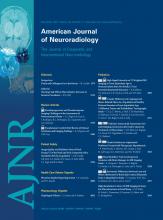Research ArticlePediatric Neuroimaging
Open Access
Brain Perfusion in Asphyxiated Newborns Treated with Therapeutic Hypothermia
P. Wintermark, A. Hansen, M.C. Gregas, J. Soul, M. Labrecque, R.L. Robertson and S.K. Warfield
American Journal of Neuroradiology December 2011, 32 (11) 2023-2029; DOI: https://doi.org/10.3174/ajnr.A2708
P. Wintermark
aFrom the Division of Newborn Medicine (P.W., A.H., M.L.)
bDepartment of Radiology (P.W., R.L.R., S.K.W.)
eDivision of Newborn Medicine (P.W.), Montreal Children's McGill Hospital, Quebec, Ontario, Canada.
A. Hansen
aFrom the Division of Newborn Medicine (P.W., A.H., M.L.)
M.C. Gregas
cClinical Research Program (M.C.G.)
dDepartment of Neurology (M.C.G., J.S.), Children's Hospital Boston, Boston, Massachusetts
J. Soul
dDepartment of Neurology (M.C.G., J.S.), Children's Hospital Boston, Boston, Massachusetts
M. Labrecque
aFrom the Division of Newborn Medicine (P.W., A.H., M.L.)
R.L. Robertson
bDepartment of Radiology (P.W., R.L.R., S.K.W.)
S.K. Warfield
bDepartment of Radiology (P.W., R.L.R., S.K.W.)

References
- 1.↵
- Perlman JM
- 2.↵
- Higgins RD,
- Raju TN,
- Perlman J,
- et al
- 3.↵
- Barks JD
- 4.↵
- Higgins RD,
- Shankaran S
- 5.↵
- Eicher DJ,
- Wagner CL,
- Katikaneni LP,
- et al
- 6.↵
- Gluckman PD,
- Wyatt JS,
- Azzopardi D,
- et al
- 7.↵
- Shankaran S,
- Laptook AR,
- Ehrenkranz RA,
- et al.,
- for the National Institute of Child Health and Human Development Neonatal Research Network
- 8.↵
- Jacobs S,
- Hunt R,
- Tarnow-Mordi W,
- et al
- 9.↵
- 10.↵
- Azzopardi DV,
- Strohm B,
- Edwards AD,
- et al.,
- for the TOBY Study Group
- 11.↵
- Polderman KH
- 12.↵
- Levene MI
- 13.↵
- Miller SP,
- Ramaswamy V,
- Michelson D,
- et al
- 14.↵
- Barkovich AJ
- 15.↵
- 16.↵
- Rutherford M,
- Counsell S,
- Allsop J,
- et al
- 17.↵
- 18.↵
- al Naqeeb N,
- Edwards AD,
- Cowan FM,
- et al
- 19.↵
- Wintermark P,
- Labrecque M,
- Warfield SK,
- et al
- 20.↵
- Wiggins GC,
- Triantafyllou C,
- Potthast A,
- et al
- 21.↵
- Luh WM,
- Wong EC,
- Bandettini PA,
- et al
- 22.↵
- Wang J,
- Licht DJ,
- Jahng GH,
- et al
- 23.↵
- Cavuşoğlu M,
- Pfeuffer J,
- Uğurbil K,
- et al
- 24.↵
- Miranda MJ,
- Olofsson K,
- Sidaros K
- 25.↵
- Barkovich AJ,
- Hajnal BL,
- Vigneron D,
- et al
- 26.↵
- Wintermark P,
- Hansen A,
- Soul J,
- et al
- 27.↵
- Laptook AR,
- Corbett RJ
- 28.↵
- 29.↵
- van Bel F,
- Dorrepaal CA,
- Benders MJ,
- et al
- 30.↵
- Bennet L,
- Rossenrode S,
- Gunning MI,
- et al
- 31.↵
- Hossmann KA
- 32.↵
- Osborn DA,
- Evans N,
- Kluckow M
- 33.↵
- Michenfelder JD,
- Milde JH
- 34.↵
- Gold L,
- Lauritzen M
- 35.↵
- Gunn AJ,
- Battin M,
- Gluckman PD,
- et al
- 36.↵
- Raad RA,
- Tan WK,
- Bennet L,
- et al
- 37.↵
- Pryds O,
- Greisen G,
- Lou H,
- et al
- 38.↵
- Jensen EC,
- Bennet L,
- Hunter CJ,
- et al
- 39.↵
- Zappe AC,
- Reichold J,
- Burger C,
- et al
- 40.↵
- Altman DI,
- Powers WJ,
- Perlman JM,
- et al
- 41.↵
- 42.↵
In this issue
Advertisement
P. Wintermark, A. Hansen, M.C. Gregas, J. Soul, M. Labrecque, R.L. Robertson, S.K. Warfield
Brain Perfusion in Asphyxiated Newborns Treated with Therapeutic Hypothermia
American Journal of Neuroradiology Dec 2011, 32 (11) 2023-2029; DOI: 10.3174/ajnr.A2708
0 Responses
Jump to section
Related Articles
Cited By...
- Long-term consequences of neonatal encephalopathy in the hypothermia era: protocol for a follow-up cohort study at 9 years of age
- Anoxic Brain Injury Detection with the Normalized Diffusion to ASL Perfusion Ratio: Implications for Blood-Brain Barrier Injury and Permeability
- Cerebral Perfusion Is Perturbed by Preterm Birth and Brain Injury
- Brain Temperature Is Increased During the First Days of Life in Asphyxiated Newborns: Developing Brain Injury Despite Hypothermia Treatment
- Brain Perfusion Imaging in Neonates: An Overview
- Medial Occipital Lobe Hyperperfusion Identified by Arterial Spin-Labeling: A Poor Prognostic Sign in Patients with Hypoxic-Ischemic Encephalopathy
- Acquisition Guidelines and Quality Assessment Tools for Analyzing Neonatal Diffusion Tensor MRI Data
- Brain Perfusion in Encephalopathic Newborns after Therapeutic Hypothermia
This article has not yet been cited by articles in journals that are participating in Crossref Cited-by Linking.
More in this TOC Section
Similar Articles
Advertisement











